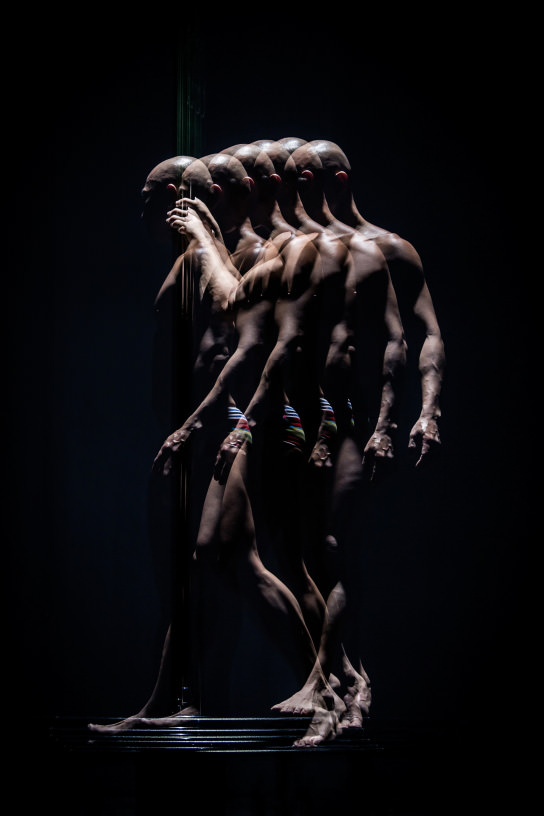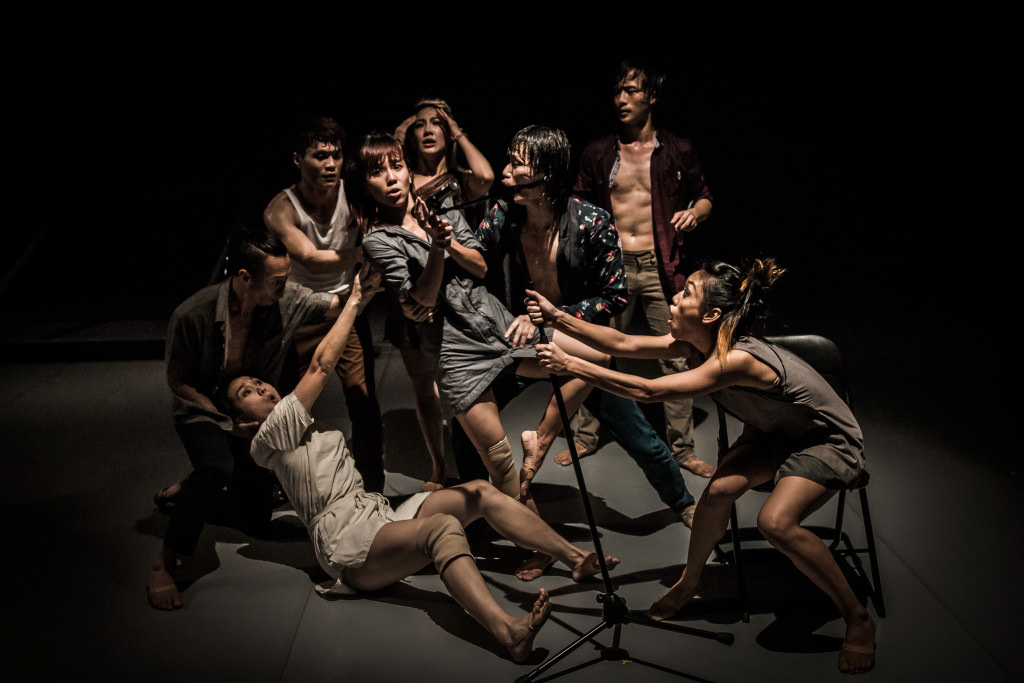Dance Photography: Expressing the Beauty of Motion and Emotion
Dance can make for stunningly beautiful photos, but it is no secret that photographing dance performance is very challenging: Framing, getting the focus and releasing the shutter at the right moment all have to be done while ensuring the best exposure with available light. For Bernie Ng, one of Singapore’s most prolific dance and performing arts photographers, it's not just about capturing action, but also the aesthetics and emotion that guide the movement. She shares some tips on how she achieves her beautifully expressive shots. (Photos by: Bernie Ng)

EOS 5D Mark III/ EF24-70mm f/2.8L II USM/ Manual exposure (f/2.8, 1/250 sec)/ ISO 2500/ WB: Auto
“Pure” by T.H.E Dance Company (2016)/ Choreography: Kuik Swee Boon/ Dancers: Anthea Seah & Wu Mi
1. Dealing with exposure
Getting the right exposure is probably the most challenging aspect of dance performance photography. The lighting on stage can be very extreme, but as flash photography is usually not permitted, you have to do what you can with the available light, which differs from show to show. Bernie advises the following:
Use large aperture lenses
This will allow sufficient light to reach the camera sensor, so that you can keep ISO speed as low as possible to minimize visible noise. Ideally, your kit should include:
- A wide-angle lens to take shots of the whole stage
- A telephoto zoom lens for close-ups.
Learn more about large aperture lenses here:
Lens Basics #9: Large Aperture Lenses
Shoot in manual, or use exposure compensation with Av or Tv mode
Conditions on stage can change very quickly, so you will want to maintain some control over your exposure settings. Bernie prefers to shoot in manual mode as it allows her to customize her settings better. But if you choose to use a semi-automatic mode, she advises using exposure compensation to get the appropriate exposure.
For beginners, aperture-priority (Av) mode is probably easier to start with: Simply set the maximum aperture, and the camera will give you the fastest shutter speed possible without underexposing. Shutter-priority (Tv) mode gives you control over the shutter speed, but it can be a bit trickier to get adequate exposure.
Shutter speed: Know what you need
Consider factors such as the type of dance, choreography, and the kind of shot that you are trying to achieve. Bernie’s go-to shutter speed is 1/250 second, which she adjusts when necessary. For example, she might decide to use a slow shutter if she feels that it adds to the image.

EOS 5D Mark III/ EF24-105mm f/4L IS USM/ Manual exposure (f/4.0, 1/13 sec)/ ISO 800/ WB: Auto
“Giving” by Frontier Danceland (2015)/ Choreography: Adrian Skjoldborg
Using a slow shutter can add dynamism and liven up the composition. Bernie says of this shot: "If I had frozen the motion, the shot would probably have looked rather ordinary." She decided to use a slow shutter speed to create motion blur, keeping the focus on the female dancer. This filled up empty spaces and added movement to the image.
Professional tip: If you have the access to the stage crew and lighting designer…
While you don’t need to know the full details of the setup, the stage crew and lighting designer could provide insights into what to expect. Bernie usually asks about the lighting setup will be, and if there will be any extreme lights.
Creative ideas: Strobe lighting can be a great opportunity!

EOS 5D Mark III/ EF70-200mm f/4L IS USM/ Manual exposure (f/4, 1.3 sec)/ ISO 320/ WB: Auto
“Planet Romeo”/ Presented at DiverCity, as part of M1 Contact Contemporary Dance Festival (2015)/ Choreographer & Dancer: Daniel Kok
Some shows involve strobe lighting, which could cause you to miss shots if you are not prepared when they come on. However, if you are prepared and respond fast enough, it could be an opportunity to get creative. For this shot, Bernie made a quick decision to slow down her shutter and create a stroboscopic effect.
2. Dance is not just about action

EOS 5D Mark III/ EF24-105mm f/4L IS USM/ Manual exposure (f/4, 1/400 sec)/ ISO 12800/ WB: Auto
The Ordinary Man by T.H.E Dance Company (2014) presented by Huayi - Chinese Festival of Arts, Esplanade - Theatres on the Bay/ Choreography: Wu Yi-San & Kuik Swee Boon
Many people think of jump shots at the mention of dance photography, but quiet moments can be dramatic too. When capturing such moments, Bernie says she pays particular attention to:
Nice lines and correct poses
Learn to identify what works well and what does not. These can be different for different dance genres. However, you don’t necessarily have to have a dance background to take decent shots—it’s mostly about good aesthetic sense. Make the dancers look good.
The faces of the dancers
A large part of dance is about conveying thoughts and feelings to the audience. Bernie tries to capture emotions and facial expressions that are appropriate for the choreography. This is when it helps to know what the choreography is about before you shoot! The intriguing facial expressions of the dancers in the shot above reflect the comedic nature of the choreography, which was inspired by Chinese crosstalk.
Look out for shots where dancers are blinking or have blank, unfocused stares (unless it’s part of the choreography)—you will probably want to screen them out.
Professional tip: Being sensitive about the shots that get seen
Keep in mind that your camera can capture things that the human eye cannot see: As you click away, you will inevitably capture shots that might not be the most flattering. Be very sensitive and careful when selecting the shots to deliver (if you are on assignment). Get permission from the dancer or company where necessary, especially if you are sharing the images on your social media, website, or anywhere public.
3. Dance photos don’t necessarily have to be full-body

EOS 5D Mark III/ EF24-70mm f/2.8L II USM/ Manual exposure (f/2.8, 1/100 sec)/ ISO 400/ WB: Auto
“Pallavi in Time” By Chowk Productions (2017)/ Choreography: Raka Maitra
Close-ups on the face or other details can also make for a very evocative images.
“Feet were very important to this choreography, and there was a lot of stamping,” Bernie recalls of the shot above. She wanted to close in on the ankle bracelets on the dancers’ feet. The shot worked out well also because the lighting was also focused on the feet. “If I had taken the shot the normal way, the upper body would have been swathed in darkness.”
Bonus: If you really want that jump shot…

EOS 5D Mark III/ EF24-105mm f/4L IS USM/ Manual exposure (f/4, 1/250 sec)/ ISO 5000/ WB: Auto
“Schubert Symphony” by Singapore Dance Theatre (2016)/ Choreography: Choo-San Goh
Jump shots are all about precise timing: "If you see the jump, you’re too late". To get the timing right, she advises not to rely too much on burst shooting. Instead, learn when to press the shutter button. Sometimes, it is possible to take cues from the music, or you might be able to identify when the dancers are preparing to jump. It will probably take a lot of trial and error, but your skills as a photographer will improve because of it.
Other things to note
1. You will need to respond very quickly
Things on stage happen quickly, and you will need to anticipate moments and respond almost instinctively in order to get the shots you want. It helps to:
- Have a fast, responsive camera like the EOS 5D series or EOS-1D X Mark II. The EOS 7D Mark II is also a good choice if you are just starting out, but you might eventually want the detail that a full-frame sensor can capture.
- Know your camera functions and configurations intuitively. Customize your buttons for quick access.
- Use back-button focus. This makes shooting more efficient as you won’t have to refocus every time after you hit the shutter button.
- Get lots of experience. Having lots of practice helps you think better on your feet.
- Watch lots of dance even when you’re not shooting. This helps you get familiar with the timing and aesthetics. Besides, it’s easier to appreciate dance for what it is when you are seeing and experiencing it through your own eyes—not through your lenses!
2. Respect who’s on stage, and respect the audience
It’s easy to get carried away with the moment, but be considerate to both the audience and to the dancers on stage.
Do…
- Shoot only when allowed
- Turn off the AF red focusing light
- Turn off your flash
Don’t…
- Get too close to the dancers. It can be distracting if you (or your huge telephoto lens) intrude into their space, especially since chances are that they will have heightened spatial awareness when dancing.
- Obstruct the view of the audience.
3. Last but not least, respect the dancers
Dancers work very hard to perfect their art, and without them, you wouldn’t have your pictures.
- Think about how they want to be portrayed. Show them in their best light, and do their efforts justice.
- Always remember to credit the dancers and choreographers in your shot. You can see that we have done so for this article!
- Build your connection with your subject. Watch more dance, or take dance classes if you are game for it! As your appreciation for the subject grows, it can reflect in the shots that you take. "When I photograph the dancers, it's almost like I am dancing with them through my lenses," Bernie shares.
The career span of dancers is short. Your photographs of them performing on stage in their element might just be the only record of those precious moments, so aim to take photos that will bring them joy and relive fond memories.
Receive the latest update on photography news, tips and tricks.
Be part of the SNAPSHOT Community.
Sign Up Now!About the Author
Bernie Ng is the main photographer for many major dance and performing arts companies in Singapore, such as Singapore Dance Theatre and T.H.E Dance Company. She also regularly collaborates with and photographs arts groups from different disciplines, as well as photographs for Esplanade - Theatres on the Bay when international artists and companies visit Singapore. Her work has been published in international dance magazines such as Dance Europe. Through her dance photography, Bernie hopes to create images for and with dancers that will bring them joy and fond memories.
Website: www.MsBernPhotography.com
Instagram: @msbern



































